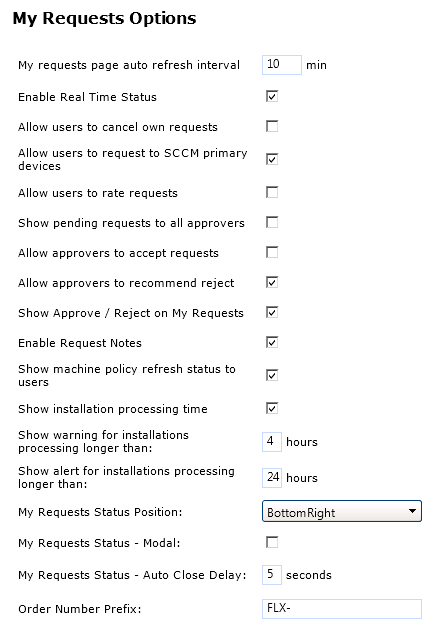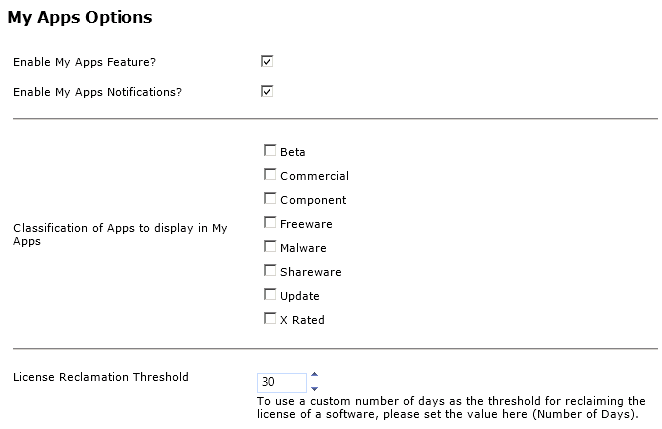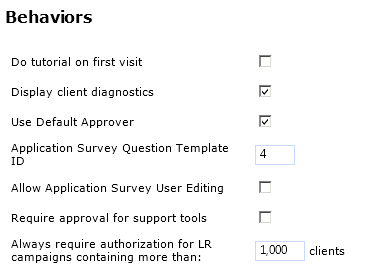
App Portal 2013 R2
On the Catalog Behavior subtab of the Web Site tab of the Settings view, you specify the behavior settings of the App Portal catalog.
The Catalog Behavior subtab of the Web Site tab includes two sets of properties:
| • | My Requests Options |
| • | Behaviors |
In the My Requests Options section of the Catalog Behavior subtab, you specify behavior settings relating to App Portal requests.

Settings View / Web Site Tab / Catalog Behavior Subtab / My Requests Options
The My Requests Options area of the Catalog Behavior subtab of the Web Site tab includes the following properties:
|
Property |
Description |
|
My requests page auto refresh interval |
Specifies the duration that the My Requests page refreshes for users. Note: Only users in roles will have the auto-refresh enabled. |
|
Enable Real Time Status |
When enabled, App Portal will check SCCM for the most recent status of a request if it is in progress. When disabled, the last status received from the bulk status update process (default is 5 minutes) will be used. |
|
Allow users to cancel own requests |
When enabled a user can cancel their requests at any stage of the request process. When disabled a user cannot cancel the request after it has been submitted to SCCM for delivery. |
|
Allow users to request to SCCM primary devices |
By default, a user can request software to their current device that they are visiting the portal from. Selecting this option will also allow the user to request to all their primary devices according to the User / Computer relationship setting on the General tab of Site Management > Settings. |
|
Allow users to rate requests |
Select to enable a rating system that allows users to give a rating and textual feedback after an application has been successfully installed. The rating will be visible for others to see as they browse the catalog. The ability to rate an item is designated by a yellow star in the Actions column after installation. |
|
Show pending requests to all approvers |
When enabled, an approver will see all the requests for which they are an approver regardless if it is their turn to approve. The checkbox will not be displayed if it is not their turn to approve. When disabled, the approver will only see the request when it is their turn to approve the request. |
|
Allow approvers to accept requests |
If this option is selected, accepting a request marks an item as acknowledged by the approver. The App Portal user interface will update to indicate which approver (from a pool of approvers) has accepted the request so that the rest of the pool does not need to take any action. Accepting a request causes approval reminder emails to stop being sent to other approvers in the pool. |
|
Allow approvers to recommend reject |
If this option is selected, recommending rejection marks your objection to approval but does not stop the advancement of the approval process to the next level. If you recommend rejection and are the last approver in the approval process, then the item is rejected. |
|
Show Approve / Reject on My Requests |
Select this option to display the Approve and Reject buttons on the My Requests tab. When this option is not selected, the approvers have to open the Approve / Reject tab and click on the request name to approve or reject the request. This option is often not selected when you use mandatory approver questionnaires where the approver will always have to open the request details to review and answer questions. |
|
Enable Request Notes |
Enable the addition of notes to existing requests. When this option is selected, the following icon will be displayed on the My Requests tab next to each request:
|
|
Show machine policy refresh status to users |
Select this option to display a small icon next to the installation status icon under the status column on the My Requests tab to indicate whether the machine policy refresh was successful. If this option is not selected, only those with the Catalog Security role of Manage All Requests will see this status icon. |
|
Show installation process time |
Select this option to display a timer, clock icon under the Info column on the My Requests tab to indicate the time that has elapsed since the installation request was issued to SCCM. When this option is not selected, only those with the Catalog Security role of Manage All Requests will see this status icon. |
|
Show warning for installations processing longer than x hours |
Display a warning to the user if an application installation takes longer than the number of hours specified. |
|
Show alert for installations processing longer than x hours |
Display an alert to the user if an application installation takes longer than the number of hours specified. |
|
My Requests Status Position |
When an item is approved, rejected, etc., a status popup opens, by default, in the bottom right of the screen. To change the position of this status popup, select another location from this dropdown list. |
|
My Requests Status - Modal |
Select this option to specify that when a status popup opens, it needs to be acknowledged by the user and manually closed. If this option is not selected, the status popup will remain open for the amount of seconds specified in the My Requests Status - Auto Close Delay field and will then automatically close. |
|
My Requests Status - Auto Close Delay |
Specify the length of time, in seconds, that a status popup will remain open on the screen. This option is not used when the My Requests Status - Modal option is selected. |
|
Order Number Prefix |
Enter the prefix that will appear prior to all request numbers. For example, if you entered RJX-, then request numbers would be RJX-1003, RJX-1004, etc. |
In the My Apps Options section of the Catalog Behavior subtab, you can enable the My Apps tab and specify My Apps options.

Settings View / Web Site Tab / Catalog Behavior Subtab / My Apps Options
The My Apps Options area of the Catalog Behavior subtab of the Web Site tab includes the following properties:
|
Property |
Description |
|||||||||||||||||||||||||||||||||
|
Enable My Apps Feature? |
Select this option to enable the My Apps tab, where users can view a list of all of the applications installed on their device(s) and address automatic and administrator-defined alerts to ensure that those applications comply with corporate software policies. Important: In order to enable the My Apps tab, you must be also connected to FlexNet Manager Platform via the Flexera Service Gateway. For more information, see Enabling the My Apps Tab. |
|||||||||||||||||||||||||||||||||
|
Enable My Apps Notifications? |
Select this option to instruct App Portal to automatically send out an email notification to users each time an alert is generated for one of their installed applications. |
|||||||||||||||||||||||||||||||||
|
Classification of Apps to display in My Apps |
To control which applications are displayed on the My Apps tab—and also which applications receive automatically-generated unused software alerts, select only the FlexNet Manager Platform classifications that you want to display.
The following classifications are available:
|
|||||||||||||||||||||||||||||||||
|
License Reclamation Threshold |
Identify the number of days that applications need to be unused in order to trigger the generation of an unused software alert, prompting users to either keep or uninstall the application. |
In the Behaviors section of the Catalog Behavior subtab, you can set options related to general website functionality.

Settings View / Web Site Tab / Catalog Behavior Subtab / Behaviors
The Behaviors area of the Catalog Behavior subtab of the Web Site tab includes the following properties:
|
Property |
Description |
|
Do tutorial on first visit |
When enabled, the user will be redirected to the Help tab and open the UserTutorial.htm file specified in Web\Help\UserTutorial.htm. Content can be entered here to train the user on their first visit. Content can include a Flash tutorial or similar training information. |
|
Display client diagnostics |
Displays an informational page as necessary if there would be an expected problem deploying software to the visiting computer. |
|
Use Default Approver |
When enabled App Portal will use the approver specified in the Email Settings > Default Approver. This approver is used when an approver cannot be determined or if approval is specified but no approver is defined. If you do not want to allow the request to complete if an approver could not be found, deselect this option and the user will receive a notification indicating that the request cannot continue. |
|
Application Survey Question Template ID |
When the Display Application Survey Tab option is selected on the Settings > Web Site > Catalog Appearance tab, this field sets the question template that is displayed on the Application Survey screen. |
|
Allow Application Survey User Editing |
Select this option to enable users to edit the list of applications displayed on the Application Survey screen. If this option is not selected, all items in the list are selected and users cannot edit them. |
|
Require approval for support tools |
When enabled requests submitted using Support Tools will be subjected to the approval process specified, if any. |
|
Always require authorization for LR campaigns containing more than x clients |
This setting helps prevent unwanted emails being generated from license reclamation campaigns by accident. Should there be more than the specified number of computers identified for license reclamation in any single campaign, the campaign will require manual authorization of the reclamation records by choosing Authorize All under the license reclamation actions menu of a specific campaign. Specify the number of clients which has to be exceeded to trigger manual authorization. The default value is 1000. |
App Portal 2013 R2 Configuration GuideDecember 5, 2013 |
Copyright Information | Contact Us |